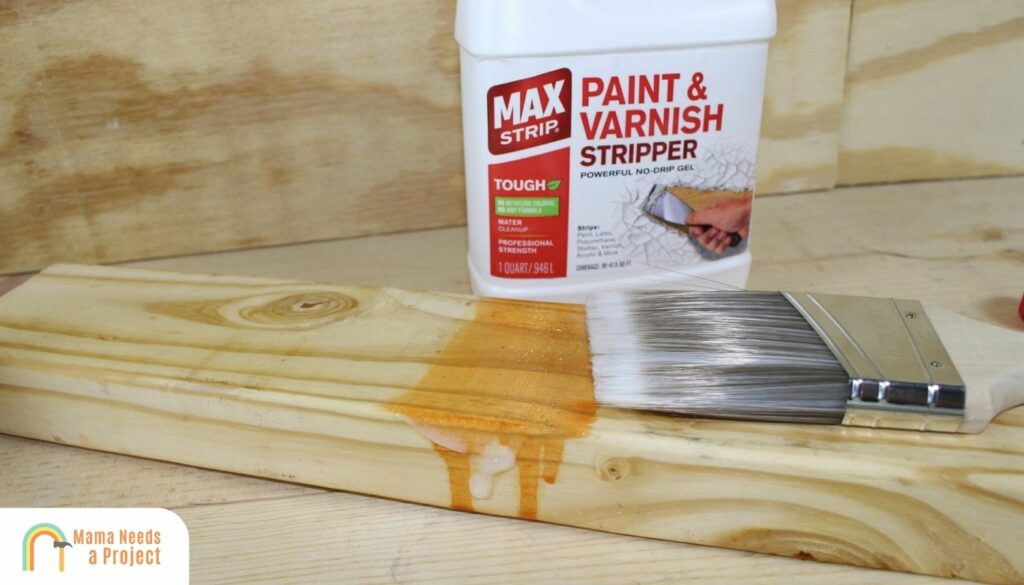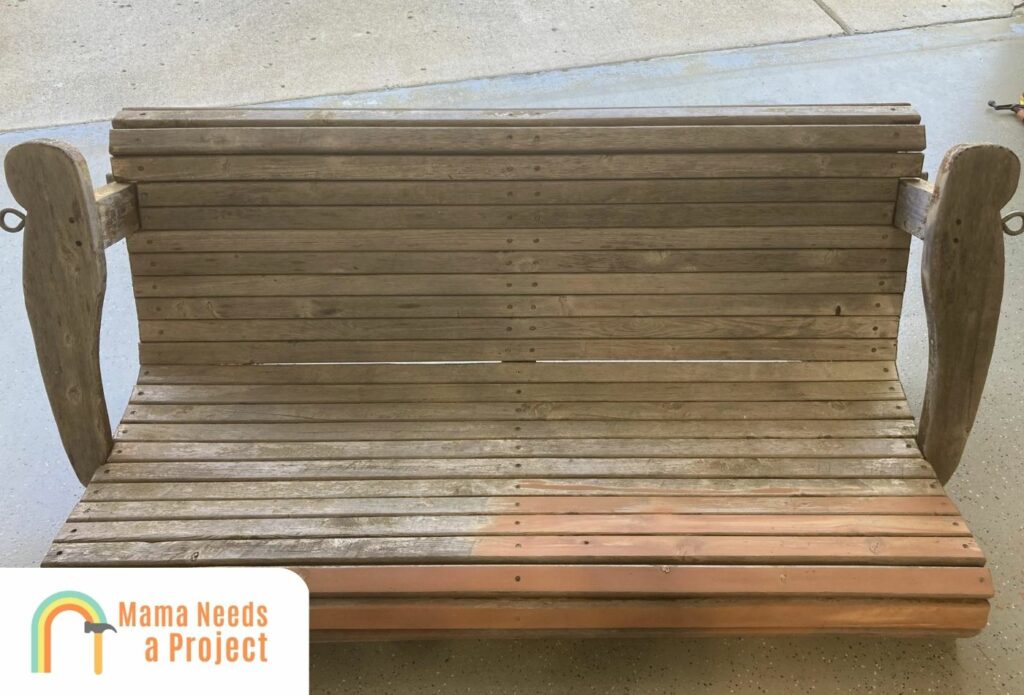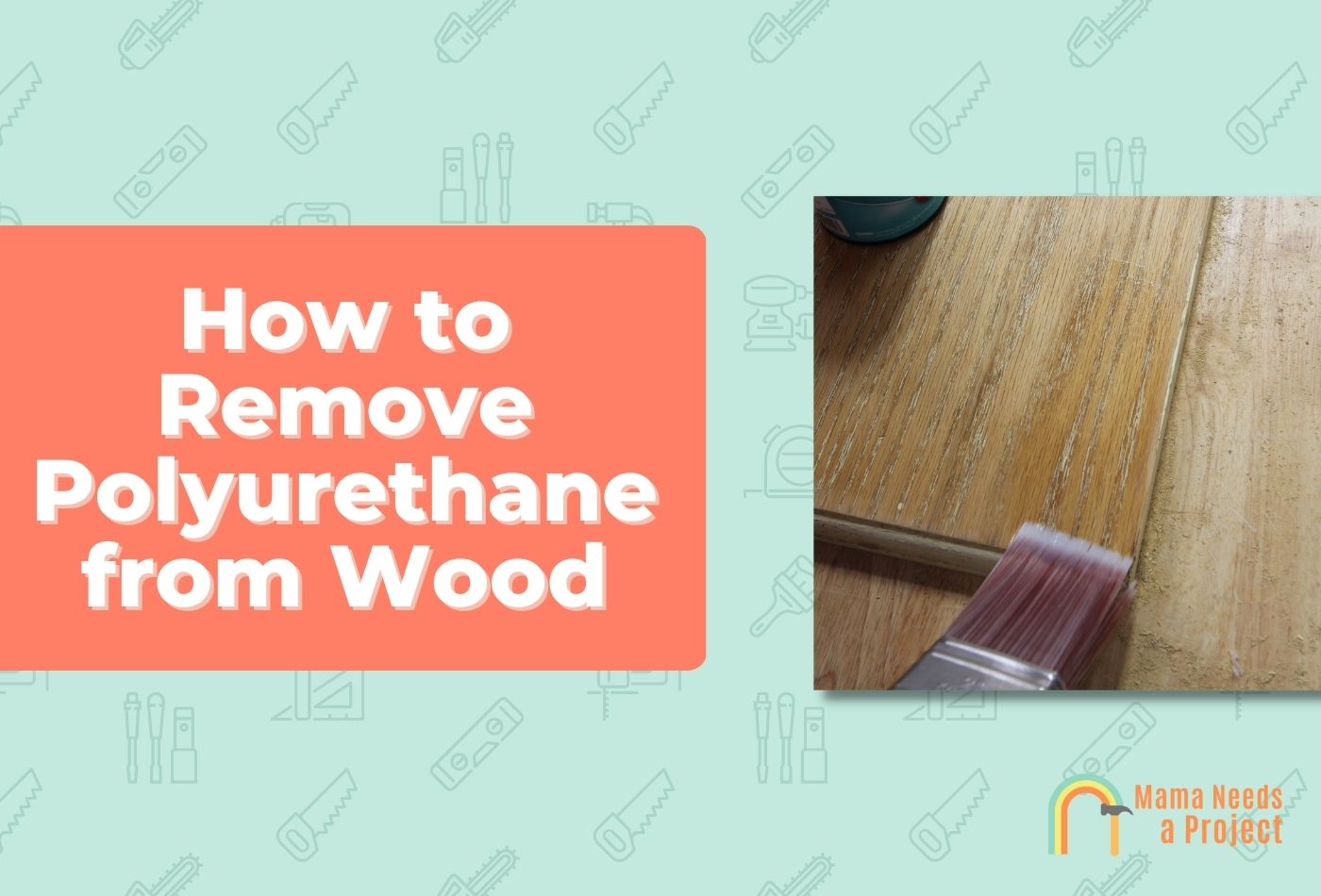How to Remove Polyurethane from Wood (3 EASY Methods)
I can’t tell you how many times I’ve applied a polyurethane finish only to find out that I don’t like how it turns out.
Maybe you used the wrong sheen of polyurethane or you’re trying to fix some polyurethane mistakes.
In this post, I’ll show you exactly how to remove polyurethane from wood so you can get the finish you want on your project. Don’t worry. It’s easier than you think!
You can remove both oil- and water-based polyurethanes from wood surfaces using paint stripper, denatured alcohol and lacquer thinner, or baking soda and vinegar.
How To Remove Polyurethane From Wood Without Sanding
Remove Polyurethane from Wood with Paint Stripper
1. Prepare
Before you apply any paint stripper to polyurethane, you need to get your materials together.
You’re going to need a paint stripper of some sort. Looking for the best polyurethane remover? Here are some of my favorites:
- Best eco friendly paint stripper: Dumond Advanced Paint and Varnish Remover
- Best budget paint stripper: Sunnyside Multi-Strip Paint Stripper
- Fastest paint stripper: Sunnyside 2-Minute Remover Gel
Also, make sure the surface you’re removing polyurethane from is easy to work with.
For example, if you’re stripping polyurethane from a door, take it off the hinges and lay it flat. Likewise, if you’re removing polyurethane from furniture, it’s best to lay a tarp out underneath so you can keep the inevitable mess contained.
Once you have your polyurethane remover, a couple scrubbers and some clean cloths, it’s time to grab your safety gear – rubber gloves, a respirator, and goggles. Also, make sure all your skin is covered, as a lot of the materials you’ll be working with can irritate the skin.
Finally, decide on a method of application: will you be wiping, brushing, or spraying the chemical stripper on the polyurethane?
If you can check all these boxes, you’re ready to apply the polyurethane stripper.
2. Apply Paint Stripper

If you’ve chosen to apply polyurethane stripper with a paintbrush, know that you’ll probably have to throw this paint brush out afterward, as it’s hard to fully remove residual paint stripper from brush bristles.
You want to be generous when coating the entire polyurethane surface with stripper; no spot should be left bare, or else the end product will be a blotchy mess.
Once the surface has been adequately coated, the stripper will start removing the polyurethane; after 10 minutes or so you should start to see results.
To ensure you don’t miss any nooks and crannies, I recommend spraying the polyurethane stripper on. You’ll be able to apply the stripper more evenly, and this method is actually safer (provided you wear all the right gear).
Wiping on polyurethane remover is really only good for antique furniture and furnishings that have many crevices, gaps, and joints.
If you want fast results after application, consider chemical-based polyurethane strippers; just be extra careful when working with these, as a lot of them contain harsh chemicals.
Water-based strippers, on the other hand, take longer to wear down polyurethane, especially oil-based products, because they don’t include these highly corrosive chemicals.
3. Scrub & Scrape

After the polyurethane remover has had ample time to wear down the poly, it’s time to start scraping and scrubbing. You’ll know the poly is ready to be removed if it’s bubbling and wrinkling.
Grab a metal or plastic scraper and start scraping the broken-down polyurethane from the wood’s surface; scraping in the direction of the wood’s grain will reduce the risk of you marring the wood with the scraper.
If you’re using a metal scraper, scrape slowly and at a 30° angle; this way you don’t gouge the wood.
Opting for a plastic scraper is a safer option, but it’ll take longer to remove the poly, as this tool isn’t as strong as its metallic counterpart.
After you’ve removed most of the poly, grab a wire brush, some fine steel wool, or a scouring pad to get polyurethane out of any nooks and crannies.
If some areas still have a lot of poly, reapply more polyurethane stripper and wait for it to wear down these concentrations. Once it has, start scraping and scrubbing again.
Repeat this process until all the poly is removed from the wood surface. You can also use a sander for removing paint to help smooth out the surface.
4. Final Touches
Once all the polyurethane has been removed from the wood’s surface, go over it with warm soapy water or mineral spirits (paint thinner).
- If you removed oil-based poly, it’s best to use mineral spirits, as this is stronger and safe for bare wood.
- If you used one of the many water-based polyurethane strippers available today, warm, soapy water will be the most effective cleaning solution.
After the surface has been thoroughly cleaned, let it dry for at least 24 hours. After such time has passed, you can add a new protective layer of polyurethane finish.
Need more help? Check out the video below to learn how to strip a polyurethane finish!
Using Denatured Alcohol and Lacquer Thinner
1. Prepare
If you can’t get your hands on paint stripper, you can combine denatured alcohol with lacquer thinner and apply this mix to polyurethane. Personally, however, I like using chemical stripper more because you don’t have to mix anything.
Here are the materials you’ll need to remove polyurethane this way:
- Denatured alcohol
- Lacquer thinner
- Wood cleaner (or soap & water)
- Steel wool
- Mixing bowl
- Paint brush
Once you have all these materials, get your safety gear, as you’ll be working with chemicals that emit fumes and irritate the skin, eyes, and throat.
Also, make sure there’s adequate ventilation in the room where you’ll be applying this mix. At least one fan should be blowing and at least one window should be open.
2. Mix
Now it’s time to mix the denatured alcohol with the lacquer thinner. Pour an equal amount of each in an empty paint can or plastic container and stir the resulting mix with a wooden stick.
If you notice lacquer settling on the sides of the container midst stirring, disperse it so there’s an adequate mix.
This mix will be strong enough to remove the polyurethane, but you won’t have to worry about harming the wood finish below.
3. Apply
It’s best to use a paint brush to apply the mix. You could spray it on, but since it’s on the thicker side I recommend skipping over this applicator unless it’s your only option.
Cover the entire polyurethane surface with the mixture, and don’t worry about overlapping brush strokes. If there are any nooks and crannies, grab a smaller brush or even an old toothbrush to apply the mix.
Removing oil-based poly? Then you’ll need to be more generous with how much mix you apply. If water-based is what you’re removing, you won’t need as much; in fact, it’s best to apply as little as possible in this case so you don’t have a big mess on your hands later on.
4. Scrub & Scrape
After the mix has had ample time to break down the polyurethane, start scrubbing it off with the fine steel wool. You could use a paint scraper first, but this isn’t necessary.
If you don’t have steel wool, a scouring pad will do. Refrain from using fine-grit sandpaper, as the poly will clog it up fast and render it ineffective.
Remember to scrub gently to avoid scratching the wood surface underneath the polyurethane. If the polyurethane is not coming off, even after you apply a bit of pressure while scrubbing, just apply more stripper later on and scrub afterwards.
You pretty much repeat the strip-and-scrub process until the vast majority of the polyurethane has been removed.
5. Final Touches
To remove the last bits of polyurethane, go over the wood surface with a damp cloth that’s been soaked in warm, soapy water. If oily poly was removed, use mineral spirits instead.
Let the surface dry for at least a day before you put a new polyurethane layer on.
How to Remove Polyurethane From Wood Without Chemicals
Use Baking Soda And Vinegar
1. Prepare
If you don’t want to use harsh chemicals to remove polyurethane, you can use a household solvent like vinegar. Here’s what you’ll need:
- Vinegar
- Corn starch
- Baking soda
- Wire brush
- Fine-grit sandpaper
- Two mixing bowls
2. Mix
To start, mix a cup of cornstarch with at least four cups of water in one bowl; mix until you get a paste. Then add four more cups of water to this paste.
In the other bowl, mix a half-cup of baking soda with a tablespoon of vinegar.
Then dump the mix in bowl two into the mix in bowl one and stir with a wooden stick for 5-10 minutes.
3. Apply
Once your mix is ready, grab a paint brush and start applying the mix to the polyurethane. As soon as the poly has been adequately coated with his homemade stripper, give it 10 to 15 minutes to dissolve.
Once you can see the poly has been broken down, it’s time to start scrubbing.
4. Scrub & Scrape
A wire brush is the best scrubber for this mix. But since these are especially abrasive, you need to be careful when scrubbing, as you don’t want to damage the wood.
Don’t worry about discoloration, as this mix won’t discolor natural wood or stained wood finish.
5. Final Touches
Before you go over the wood’s surface with warm soapy water or mineral spirits, sand it to remove the last bits of poly buildup.
Sanding at this point will also be a wise move if your plan is to apply clean polyurethane afterward.
Tips for Removing Water-Based Polyurethane
If you’re stripping polyurethane that’s water-based, you should use a minimal amount of stripper.
After all, water-based polyurethane isn’t the strongest finish, so you won’t need a lot of chemical firepower to break this down.
Should you apply too much chemical stripper, it’s likely you’ll have a big mess on your hands, one that can be a pain to clean up because of the chemicals involved.
Water-based strippers are best for water-based polys, as they have a lot of ingredients in common, the main one being water, the universal solvent.
Since polyurethane that’s water-based is generally thin, you need to be extra careful when removing it, otherwise you could easily scratch or gouge the wood below.
Tips for Removing Oil-Based Polyurethane
It’s best to use chemical-based polyurethane strippers when you have to remove oil-based poly, as non-chemical strippers aren’t as good at wearing down oily poly.
Also, when you apply stripper to this kind of poly, you’ll know it’s time to remove the poly when you see it start to discolor. In other words, when its yellowish/amber tone is accentuated, take this as a sign that it’s time to start scraping and scrubbing.
FAQs
Does vinegar remove polyurethane from wood?
Yes, vinegar can be used to remove polyurethane from wood. However, you need to combine this with baking soda to make it truly effective. The vinegar is the solvent while the soda acts as the abrasive.
How do you remove dried polyurethane?
Removing polyurethane is a lot easier if it’s been allowed to cure completely. Oil-based products take a month to cure, whereas water-based products cure in under two weeks. Removing poly that isn’t fully cured can create a big mess and ruin your sandpaper.
Does Murphy’s Oil Soap remove polyurethane?
No, this product will not remove a polyurethane finish. This is a cleaning agent, not a finish remover. Choose one of the polyurethane removers above when you need to get rid of this varnish.
Will Goof Off remove polyurethane?
Goof Off can remove polyurethane from wood. It’s a strong, chemical-based polyurethane remover, yet you don’t have to worry about it damaging the wood grain when you apply it. It’s an effective varnish stripper overall, and after application you’ll just need to do some light sanding to clear any poly from the entire surface.
Will paint thinner remove dried polyurethane?
Yes, paint thinner, otherwise known as mineral spirits, will remove dried polyurethane, but only after a stripping agent has had a chance to wear the poly down. Mineral spirits alone won’t remove polyurethane from wood. If anything, it’d clean the poly, making it smoother and more visually appealing.
Final Thoughts
Removing polyurethane from a wooden surface may seem difficult, but there are three simple methods you can use to accomplish this. You could:
- Remove polyurethane with a chemical paint stripper.
- Combine denatured alcohol with lacquer thinner and use this mix to break down poly.
- Break down the poly with a soda-vinegar mix.
None of these methods will put the wood’s grain or natural color at risk, and after the poly has been thoroughly removed the surface will be ready for a new finish.
In my experience, the best way to remove polyurethane is using a paint stripper as it’s the easiest method I’ve found.




